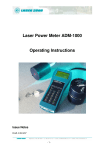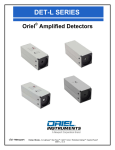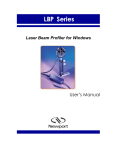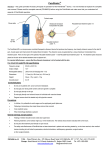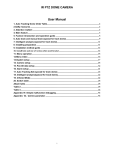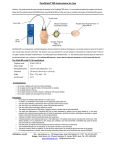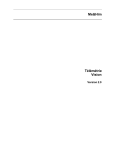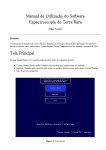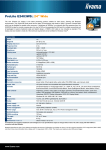Download duma optronics ltd.
Transcript
Analyzer Specifications BA7 Head Drawing BA3 Head Drawing 87 35.2 37.5 34.3 15 35.5 15 13.1 87.5 13.1 Multiple Scanning Knife-Edge Beam Profiler Æ 11 11 Æ 105 38.0 32.8 8 Æ6 3âM4 threaded 15 2.7 9 5 Æ6 105 3âM4 threaded M6 thread 2âM4 threaded 5.5 13.2 5.5 3.5 Knife-edge plane 50 entrance aperture Æ5.4 2âM4 threaded M4 thread 3.5 50 15 4.9 Æ25 M22â0.5 thread 13.2 removable filter removable filter Dimensions are in mm Sensor type Wavelength range Number of blades Beam size range 3µm-5mm 15µm-10mm 15µm-9mm 3µm-3mm 15µm-3mm 3µm-5mm 15µm-5mm Beamwidth resolution Beamwidth accuracy Power accuracy Power range Saturation Power resolution Position accuracy Position resolution PC interface Temperature Sensor head weight Measurement rate CE Compliance Silicon (Si), UV-Silicon (UV-Si) or InGaAs (IR) Si 400-1100nm UV-Si 190-1100nm IR 800-1800nm 3 for BA3 heads, 7 for BA7 heads Host Computer Requirements Pentium III, 128MB RAM, 10MB Free HDD, 8 MB 16 bit VGA card, CD ROM any type, 1 free ½ size PCI slot, OS: Windows 98/ME/NT 4.0/2000/XP Ordering Information for BA3-Si and BA3-UV for BA7-Si and BA7-UV (Oval) for BA7-Si and BA7-UV (Round) for BA3-IR3 for BA7-IR3 for BA3-IR5 for BA7-IR5 1µm for beams>100 mm in size, 0.1µm for beams<100µm in size ±2% ±5% for Si and UV-Si heads, ±10% for InGaAs heads 10µW to 1W with filters for Si and UVSi heads, 10µW to 5mW (no filters provided) for the InGaAs heads 0.1 W/cm² without filter, 20W/cm² with NG9 (Si and UV-Si ) 0.1µW ±15µm 1µm ½ size P&P PCI card -10º to 50ºc 755 Gram with cable 5Hz The system consists of a measuring head with 2.5m long attached cable, a post, ½ length PCI card, NG4 and NG9 filters in housing (for Si and UV-Si heads), software on CD disk, carrying case. BA3-Si 3-blades, Si detector 5mm circular BA7-Si 7-blades, Si detector 9mm square BA3-UV 3-blades, UV-Si detector 5mm circular BA7-UV 7-blades, UV-Si detector 9mm square BA3-IR3 3-blades, InGaAs detector 3mm circular BA7-IR3 7-blades, InGaAs detector 3mm circular BA3-IR5 3-blades, InGaAs detector 5mm circular BA7-IR5 7-blades, InGaAs detector 5mm circular Optional Accessories BA-Fiber BA-Mount A fiber adapter with an FC connector designed to fit onto the aperture of the BA head close to the knife-edge aperture. An optional mount is available to enable rotation of the BA head about the Optical axis. The mount has 360 degree calibrated scale with locking screw. Main Applications: - Laser beam analysis: Profile, beam size, position, power - QC of lasers - Monitor multiple beams centroids High precision beam diagnostics for CW lasers Patented technology: Unique tomographic image reconstruction of 2D/3D images Versatile: Meaure beam profile, beam size, beam shape, position and power Flexible: Wide spectral range, from 190nm through 1800nm Accurate: Beam sizes from 3mm to 9mm with 0.1mm resolution Compact: Based on a PCI card, measuring head, software Main Software Features Real time beam profiles, beam size and gaussian fit 2D/3D plots of beam in real time Beam centroid and ellipticity, Power measurement Direct data logging to Excel files Data streaming via RS232 or TCP/IP Save image and snapshot files Automatic Pass/Fail analysis report ActiveX software for integration in users program DUMA OPTRONICS LTD. DUMA OPTRONICS LTD. 1st Hazait St., P.O.Box 3370 Nesher 20306, Israel Tel:972-4-8200577 Fax: 972-4-8204190 Website:http://www.duma.co.il E-mail:[email protected] 1st Hazait St., P.O.Box 3370 Nesher 20306, Israel Tel:972-4-8200577 Fax: 972-4-8204190 Website:http://www.duma.co.il E-mail:[email protected] Patented Technology System Presentations (cont.) The Beam Analyzer provides a bridging technology, producing the 3D intensity reconstruction of CCD cameras, while being capable of measuring very small spots at high resolution and huge dynamic range 2D and 3D Intensity Plots The measuring technique is based on a multiple scanning knife-edge technology, combined with a tomographic image reconstruction for the creation of the 2D/3D display. When the drum spins, the knife-edges cut across the beam in an orthogonal plane to the direction of propagation. A stationary large detector inside the spinning drum measures light intensity. For attenuation, when needed, a built-in distortion free optical filter is inserted between the spinning drum and the detector. This technique provides the required attenuation without affecting beam quality. Each scanning knife-edge is oriented at a different angle on the drum and moves across the beam path in a different direction as the drum rotates. Consequently, during a single rotation of the drum, the instrument generates a set of profile curves, each representing the intensity profile of the beam from a different direction. This data is the input for the tomographic reconstruction algorithm to generate the 2D/3D intensity profile of the beam. The Beam Analyzer is offered in two types of measuring heads: The BA7 uses seven individual knife-edges, providing more accurate Filter Knife edge measurement of the true beam shape and dimensions by gathering data from all 7 scans, while the BA3 uses only three knife-edges, and is recommended for smaller beams measurement as well as for Sensor Laser Beam a near-Gaussian beams. The more knife-edges, the greater the level of detail obtained. For a beam distribution that is significantly nonGaussian the BA7 would reconstruct a plot that closely matches the Rotating drum real beam. The Projection function provides either a 2D or a 3D plot of the beam intensity profile, and is created using reconstructive tomography. The 2D contour maps and the 3D isometric plots can be displayed with or without scan axis and grids. These plots can be rotated along the beam optical axis, as well as be flipped. This feature enables the user to view the image from various angles around the beam. It is also possible to control the 3D plot wire density. Data about the beam size and centroid position is displayed digitally along with centroid and beam size data. 2D Plot 3D Plot Power Measurement The beam power can be displayed either as a digital readout, or as a bar-type display or in combination with an analog needle. Power presentation units can be chosen as mW, µW or dBm. The user can offset the zero to deactivate the ambient light suppression. Pre-defined filter transmission files can be selected. A test range can be defined and displayed to monitor beam power within specific limits, audio alarms are optional. System Presentations Beam Analyzer provides an extensive range of graphical presentations and analysis of laser beam parameters. Beam Position and Ellipticity Beam Profiles and Width The beam centroid position is continuously monitored relative to the center of the sensor area in real-time, along with beam shape, ellipticity (major and minor axes) and angular orientation. A zoom function is available for viewing the footprint of small beams more clearly. Observing beam position stability versus time is available upon setting up of the Chart function to monitor beam position at the selected clip level. Beam Analyzer control software simultaneously displays two profiles from two orthogonal knife-edges, or show each profile individually for greater visual detail. These main profiles, located at 45 degrees from the base of the head, are called V and W. Beam widths are digitally displayed for any three user selected clip levels, with up to 0.1µm resolution. The beam profile displays are auto-scaled (optional) to maximize on-screen detail and resolution. Added detail can be obtained in a special high-resolution mode. A Gaussian fit profile can be overlaid on profiles in real time, while the correlation and fit values are displayed digitally. Zoom function automatically increases the displayed spatial resolution. Chart mode It is frequently necessary to monitor the Beam Width (or alternatively Beam Position) as a function of time. In Chart Mode, these parameters can be viewed in strip chart format, showing long term time-dependent stability or drift. The measured data can be viewed on screen, saved or printed for further analysis. Beam Analyzer by DUMA OPTRONICS LTD. More Software Features - Pass/Fail testing can be performed on measured results for acceptance within specific tolerances. - Data logging to a Text file or to Excel file - Live Snapshot files replay for complete analysis of results - Average setting, Zooming - TCP/IP communication protocol and remote control - Data transmission via RS-232 link to another computer - Slave Mode controlling the measurements upon request - Screen images can be saved as BMP/JPG files or printed out - ActiveX software for integration in users application program Beam Analyzer by DUMA OPTRONICS LTD. CCD Beam Profiler Main Applications: - Laser beam analysis: Profile, beam size, position, power - QC of lasers - Monitor multiple beams’ centroids Expanding your profiling capabilities Patented technology: Wide dynamic range enabled by double sampling technology Versatile: A complete test station, measures both CW and pulsed beams Flexible: A wide spectral response from deep UV (190nm), VIS and up to 1550nm Portable: Based on a USB 2.0 attachment for notebooks, or on a PCI card Easy to use: user-friendly software, on-line help routine Main Software Features Real time beam size and gaussian fit 2D/3D plots of beam in real time Software controlled electronic shutter & gain Video with playback, snapshot files Data exporting to another computer via RS232 Data logging with detailed statistics ActiveX package to control software from your application Automatic Pass/Fail analysis report DUMA OPTRONICS LTD. 1st Hazait St., P.O.Box 3370 Nesher 20306, Israel Tel:972-4-8200577 Fax: 972-4-8204190 Website:http://www.duma.co.il E-mail:[email protected] System Presentations BeamOn provides an extensive range of graphical presentations and analysis of laser beam parameters. Beam Profiles and Width Two types of profiles are being displayed; Sum Profiles-Displays the two orthogonal profiles, one along the vertical axis and one along the horizontal axis. Each profile is composed of a summation of rows Horizontal Profile and columns at a beam cross-section. Line Profiles-Displays the beam contour along a line parallel to the vertical and horizontal axes. These two orthogonal lines are designated as a cross hair cursor on the image plane and can be moved along the working area. Results Beam widths are digitally displayed for any three user selected clip levels. A Gaussian fit profile can be overlaid on profiles in real time, while the correlation and fit values are displayed digitally. A Top Hat profile presentation and fit is also available. 2D and 3D Intensity Plots The Projection function provides either a 2D or a 3D plot of the beam intensity profile. A zooming feature enables magnification of the displayed image. It is possible to control the 3D plot wire density. For a weak beam image, even at max shutter and gain settings. Use the beam intensity pallet to optimize color display. Beam Intensity Pallet The 3D plot can be rotated along the beam optical axis, as well as be flipped. This feature enables the user to view the image from various angles around the beam. 3D Plot - side view 3D Plot - top view 2D Plot Power Measurement The beam power is displayed as a digital readout at the status bar. A power calibration function allows the user enter a “base” power value. In subsequent captured images the summed intensity of all pixels will be proportional to this value. BeamOn by DUMA OPTRONICS LTD. System Analysis BeamOn provides an extensive range of laser beam parameters calculation and analysis. Beam Position The beam centroid is continuously monitored relative to the center of CCD head. Three Regions of Interest (ROI) can be defined by the user, thus enabling the user to monitor up to 3 beams’ centroids simultaneously. Detailed Statistics The information in Statistics screen is updated in real time and is useful for analyzing beam characteristics. It lists the information in a table format and shows the actual measurement values, as well as the MIN (minimal measurement), MAX (the maximal measurement), AVER (the averaged value), and STD (the standard deviation) of several parameters which are crucial for beam analysis: - Centroid (H / V profiles) - Beam Peak (H / V Proflies) - Beam width at 3 clip levels (H / V Profiles) - Correlation to Gausian profile (H / V Profiles) - Power (mW) Statistics Analysis and QA Testing Elipse estimation Distance measurement Test The software enables a best fit to an elipse as well as direct distance measurement. The Elipse function calculates the best-fit elipsoid for the examined beam. The major and minor axes of the fit elipse are calculated as well as the orientation of the major axes of the fit. The Distance measurement function calculates the distance between any two points on the beam image, the points are being selected by the user. The Test routine allows the user to test a laser beam based on user-defined Pass/Fail criteria. The test results are calculated for any one of the beam calculated parameters. More Software Features - Data logging to a Text file (up to 99 hours) - Average - Zooming - Printing of text and images - User set threshold levels - Full on line Help routine - Live Snapshot files replay for complete analysis of results - Capture up to 12 still images - Setup for different camera types (for PCI version) - Multiple PCI boards operation (Windows 2000/XP) - Full session recordings for off-line analysis (Mpeg) - Customer set Pass/Fail criteria - Tile images in matrix format - Direct link to Duma’s website for support BeamOn by DUMA OPTRONICS LTD. Specifications CCD Head Drawing: CCD Head Specifications 48 Ref. UN 3/4”-32 Stackable filters 64 34.3 4.6 8.5 RCA OUT Sync Camera type: Pixel size: Sensor active area: Weight: Sync out: Power consumption: Accessories included: C-mount to UN 3/4”-32 Converter UNC-8-32 Thread deep 6 Cable length 2.5 m to 8 pin mini Din Detector surface Ø12 Dimensions are in mm General Specifications PC interface: RS232: Operating temp: Storage temp: CE compliance Monochrome interline transfer CCD •” format 8.6µm(H)X8.3µm(V) 6.47mmX4.83mm 295 gr. with cable RCA female jack, 4.5V square wave TTL output 5V, 0.9Watts 3XNG 1.6mm thick Schott colored filters in housing about 240:1 (wavelength dependent), cap, mounting post 1/3 size P&P PCI card or USB2.0 Attachment Data out -10ºc to 50ºc -40ºc - 60ºc Ordering Information The system comes with a camera, a post, a set of 3xNG Schott colored filters (NG4, NG9, NG10) in housing, a PCI card or a USB2.0 Attachment, software on CD disk, carrying case and user manual. Select PC interface when ordering. spectral range 350-1100nm BeamOn-VIS (PCI or USB2): 190-1100nm BeamOn-UV (PCI or USB2): BeamOn-IR1310 (PCI or USB2): 350-1310nm BeamOn-IR1550 (PCI or USB2): 350-1100nm Plus 1550nm±50nm 1.6mm thick Schott colored filter NG Filter: in mount, select type:4/9/10 Attachment for high power lasers BeamOn-Sampler: attenuation (up to 20W) Host Computer Requirements Pentium III (IV, 1GHz for USB2.0 ver), 128MB RAM, 10MB Free HDD, 16 MB 16 bit color VGA card, resoloution 1024X768, CD ROM any type, 1 free 1/3 size PCI slot (or 1 free High Speed USB2.0 port), OS Win2000/XP (also Win98/Me for PCI ver). System Performance with Software System Response VIS 350-1100nm UV 190-1100nm IR1310 350-1310nm IR1550 350-1100nm and 1550nm (*) (*) Model IR1550 is based on the standard CCD for VIS which is coated with a conversion coating, enabling capture of signals at the 1550nm range +/-50nm. 25Hz 640X480 1/50 to 1/10000 sec, 8 steps 6dB to 30dB, 8 steps In CW mode Null function is available to automatically subtract background Optical dynamic range: up to 1X1011 using all filters and software controlled electronic shutter and gain Max frame rate: Image resolution: Shutter speed: Gain control: Null: Damage threshold: Sensitivity: Saturation: Operation with pulsed lasers: Triggering: Max frequency for single pulse display: 50W/cm2 with filters ~5nW/cm2 at 633 nm (models VIS, UV) ~15µW/mm2 at 1310 nm (model IR 1310) ~50µW/mm2 at 1550 nm (model IR 1550) ~1mW/cm2 , no filters (models VIS, UV) ~5mW/cm2 no filters (model IR 1550) Ability to capture and replay images from slowly pulsing lasers (1-100Hz) while filtering out frames with no laser pulse. Provision for displaying single shot pulses. In pulsed mode set threshold by slide bar to display frames with captured pulses 10KHz DUMA OPTRONICS LTD. 1st Hazait St., P.O.Box 3370 Nesher 20306, Israel Tel:972-4-8200577 Fax: 972-4-8204190 Website:http://www.duma.co.il E-mail:[email protected] m Beam The Analyzer for Microscopic beams Measures microscopic beams of Wide spectral response range less than 0.5µm (FWHM) User friendly software Handles CW or pulses at low or high Full Stand Alone instrument, repetition rates or USB 2.0 interface with powerful software Measure mW to Watts with included filter Excellent for industry and laboratory Long working distance (Objective to object) Optical zooming for fast beam finding New! High resolution, high responsivity Excellent for fast focusing 800,000 pixel CCD readout device DUMA OPTRONICS LTD. 1st Hazait St., P.O.Box 3370 Nesher 20306, Israel Tel:972-4-8200577 Fax: 972-4-8204190 Website:http://www.duma.co.il E-mail:[email protected] Main Software Features Graphical presentation of a laser beam in 2D/3D. Three ROIs (Region of Interest) user-selectable. Centroid and beam width profile calculation to sub micron accuracy. User adjustable dynamic range by controlling the built-in electronic shutter speed and gain. Performs Test analysis Measures CW or pulsed beams. Specifications Real time beam measurements: Beam size at 3 clip levels with Gausian fit Total intensity (sum profile) along XY axes XY profiles selectable by anchor point & rotation Real time position measurements Data logging with detailed statistics Video with playback Save / View images, snapshot files Digital Zooming Full on line instructions and help Camera and Magnification Camera type CCD 1/6 format, with approx. 800,000 effective pixels Spectral Response 350 - 1310nm (For IR range, IR corrected objective is required) Magnification Infinite conjugate objective and magnifying lens. Objective magnification is x100; x50 ; x20 ; x10 user selectable. Built-in motorized zooming function. Beam finding feature Equipped with a zooming lens for observing large areas. Optical dezooming up to 1/25 from objective magnification. Attenuation: Built in NG10 filter (removable) Configuration Tube type zooming microscope equipped with M6 mounting thread. Dimensions: Weights: 163.5mm (L) x 83mm diameter (without objective and base) 2.56Kg Lens Working Distance (W.D.): 6mm (for x100), 13mm (for x50), 20mm (for x20), 33.5mm (for x10), parfocal distance 95mm. USB 2.0 interface, Windows 2000 / XP (Pentium IV 1.6 GHz) Pentium III 800MHz and up, 64MB RAM 2.5 HDD 6GB, Windows 98/Windows 2000 Color VGA card 1024x768 resolution, 2MB RAM One PS2 mouse port, one PS2 keyboard port, One LAN Ethernet port ,One serial port with RS232 One FDD 3.5 ,Two USB ports 100W power supply, AC input voltage: 90 VAC to 264 VAC 4 operating buttons on console for fast access to the following functions: Print, Log, Link, Exit 125(W) x 252(H) x 268 (D) mm 5.5Kg USB 2.0 version: Stand Alone unit specifications: Stand Alone unit Dimensions Stand Alone unit Weights System Performance with Software: Minimum measurable beam size Maximum frame rate 0.5 µm for x100 objective 30Hz (CW lasers) Ordering Information Model uBeam-X- USB 2.0 : A complete system based on a measuring head with USB 2.0 interface and Windows 2000/XP application program, select type of objective magnification (X) X (Objective magnification): x100, or x50, or x20, or x10 Model uBeam-X-SA : A complete system based on a measuring head and stand alone control unit, select type of objective magnification (X) DUMA OPTRONICS LTD. 1st Hazait St., P.O.Box 3370 Nesher 20306, Israel Tel:972-4-8200577 Fax: 972-4-8204190 We b s i t e : h t t p : / / w w w. d u m a . c o . i l E - m a i l : s a l e s @ d u m a . c o . i l

















